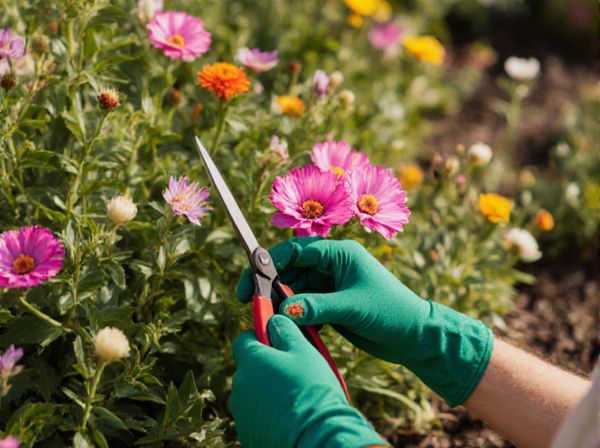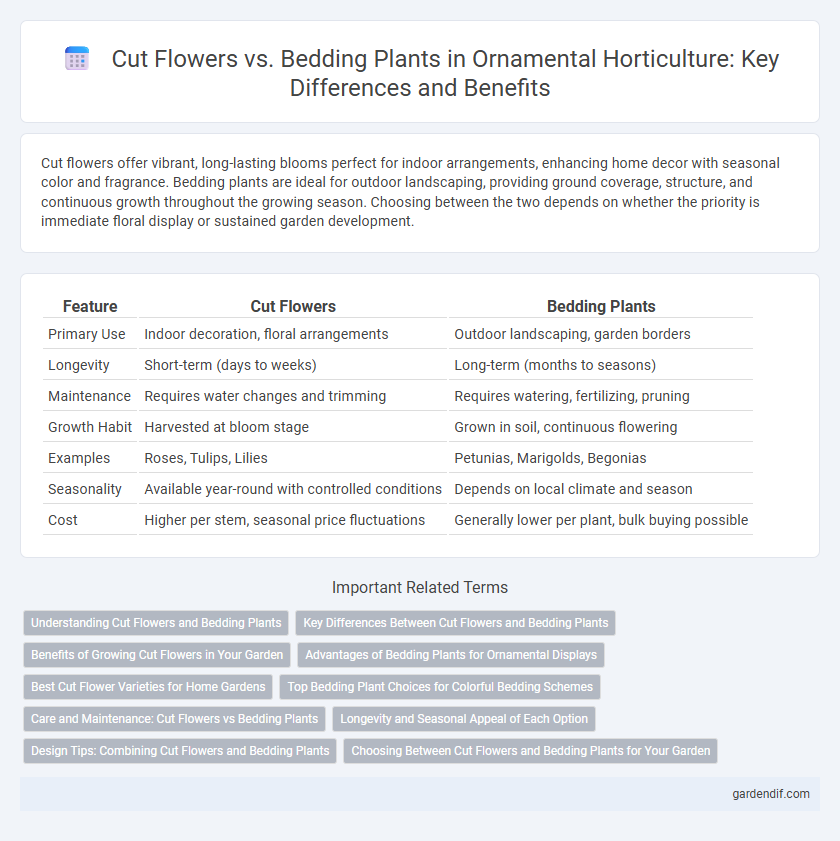
Cut flowers vs Bedding plants Illustration
Cut flowers offer vibrant, long-lasting blooms perfect for indoor arrangements, enhancing home decor with seasonal color and fragrance. Bedding plants are ideal for outdoor landscaping, providing ground coverage, structure, and continuous growth throughout the growing season. Choosing between the two depends on whether the priority is immediate floral display or sustained garden development.
Table of Comparison
| Feature | Cut Flowers | Bedding Plants |
|---|---|---|
| Primary Use | Indoor decoration, floral arrangements | Outdoor landscaping, garden borders |
| Longevity | Short-term (days to weeks) | Long-term (months to seasons) |
| Maintenance | Requires water changes and trimming | Requires watering, fertilizing, pruning |
| Growth Habit | Harvested at bloom stage | Grown in soil, continuous flowering |
| Examples | Roses, Tulips, Lilies | Petunias, Marigolds, Begonias |
| Seasonality | Available year-round with controlled conditions | Depends on local climate and season |
| Cost | Higher per stem, seasonal price fluctuations | Generally lower per plant, bulk buying possible |
Understanding Cut Flowers and Bedding Plants
Cut flowers are cultivated primarily for their blooms, harvested at peak freshness to enhance floral arrangements with maximum vase life, whereas bedding plants are grown mainly for continuous outdoor display, valued for their foliage and flowering durability in garden beds. Understanding the growth requirements, seasonal availability, and maintenance needs of cut flowers like roses, lilies, and tulips differs significantly from bedding plants such as petunias, begonias, and impatiens, which thrive with periodic watering and fertilizing in landscape settings. Selecting the appropriate ornamental type depends on the intended use, indoor versus outdoor placement, and desired aesthetic longevity.
Key Differences Between Cut Flowers and Bedding Plants
Cut flowers are cultivated primarily for their blooms, harvested for floral arrangements, and typically have a limited lifespan after cutting, while bedding plants are grown for landscape decoration, providing longer-term color and texture in gardens. Cut flowers often require specific growing conditions to produce high-quality blooms suitable for transport and display, whereas bedding plants are selected for durability and adaptability in outdoor environments. The key differences lie in their intended use, lifespan after harvesting, and cultivation techniques tailored to maximize floral appeal versus garden integration.
Benefits of Growing Cut Flowers in Your Garden
Growing cut flowers in your garden provides a constant supply of vibrant blooms ideal for fresh floral arrangements, enhancing both indoor aesthetics and mood. These flowers often require less maintenance and space compared to bedding plants, making them a practical choice for gardeners seeking efficient use of their plots. Harvesting cut flowers promotes healthier plant growth by encouraging continuous blooming throughout the season.
Advantages of Bedding Plants for Ornamental Displays
Bedding plants offer longer-lasting visual appeal compared to cut flowers, as their continuous growth provides sustained color and texture throughout the season. Their ability to create diverse, layered arrangements makes them ideal for large-scale ornamental displays in gardens and public spaces. These plants also improve soil health and support local ecosystems by attracting pollinators, enhancing both aesthetic and environmental value.
Best Cut Flower Varieties for Home Gardens
Best cut flower varieties for home gardens include roses, lilies, and sunflowers due to their vibrant colors, long vase life, and ease of cultivation. These cut flowers provide continuous blooms and enhance floral arrangements with diverse shapes and fragrances. Choosing varieties like dahlias and zinnias combines aesthetic appeal with reliable growth, making them ideal for ornamental cutting gardens.
Top Bedding Plant Choices for Colorful Bedding Schemes
Top bedding plant choices for colorful bedding schemes include vibrant selections like petunias, begonias, and marigolds, which provide continuous blooms and rich hues throughout the growing season. Unlike cut flowers that require regular harvesting, bedding plants offer lasting visual impact and can be arranged to create intricate patterns and textures in outdoor landscapes. Their adaptability to various soil conditions and seasonal resilience makes them ideal for dynamic, eye-catching garden displays.
Care and Maintenance: Cut Flowers vs Bedding Plants
Cut flowers require precise water management and frequent trimming to extend vase life and maintain freshness, while bedding plants demand regular watering, fertilization, and pest control to promote healthy growth and vibrant blooms. Cut flowers are often sensitive to temperature and humidity fluctuations, necessitating controlled environments, whereas bedding plants adapt better to outdoor conditions but need soil quality monitoring. Maintenance of cut flowers focuses on post-harvest care, whereas bedding plants require ongoing horticultural practices throughout their growth cycle.
Longevity and Seasonal Appeal of Each Option
Cut flowers offer vibrant color bursts and fragrance but typically last only a week to ten days once cut, requiring regular replacement for sustained appeal. Bedding plants provide long-lasting seasonal interest, enduring several months in garden beds with continuous growth, flowering, and foliage changes. Choosing between them depends on the desired longevity and whether immediate decorative impact or extended seasonal presence is prioritized.
Design Tips: Combining Cut Flowers and Bedding Plants
Combining cut flowers and bedding plants creates dynamic garden compositions by mixing textures, colors, and bloom times, enhancing visual interest and seasonal appeal. Incorporate tall cut flowers such as delphiniums or sunflowers alongside low-growing bedding plants like petunias or begonias to add vertical contrast and depth. Design garden beds with layering techniques, using bedding plants as colorful ground cover while arranging cut flowers in clusters or focal points for an eye-catching display.
Choosing Between Cut Flowers and Bedding Plants for Your Garden
Cut flowers provide vibrant, long-lasting blooms ideal for indoor arrangements, enhancing home decor with seasonal color. Bedding plants offer prolific growth and versatility, creating dense, colorful ground cover that defines garden spaces and supports pollinators. Selecting between cut flowers and bedding plants depends on the garden's purpose, maintenance level, and desire for indoor floral beauty versus outdoor landscape impact.
Cut flowers vs Bedding plants Infographic

 gardendif.com
gardendif.com